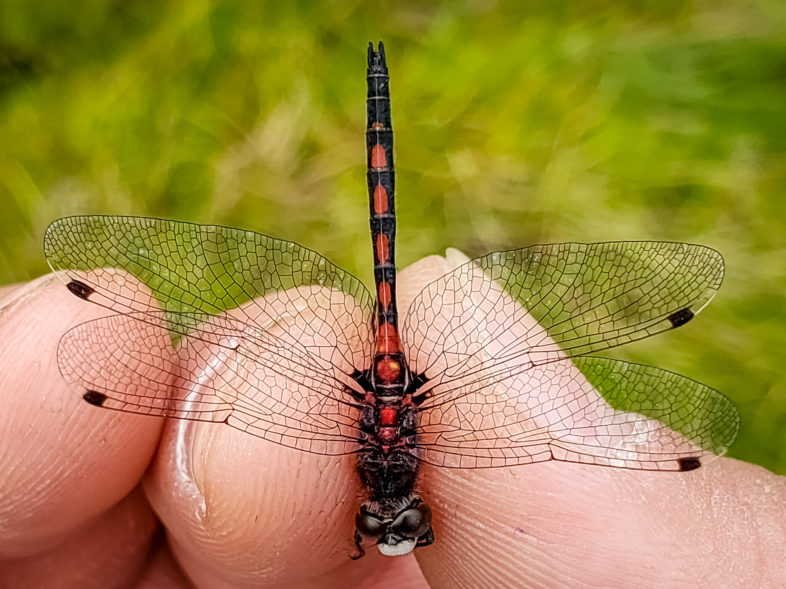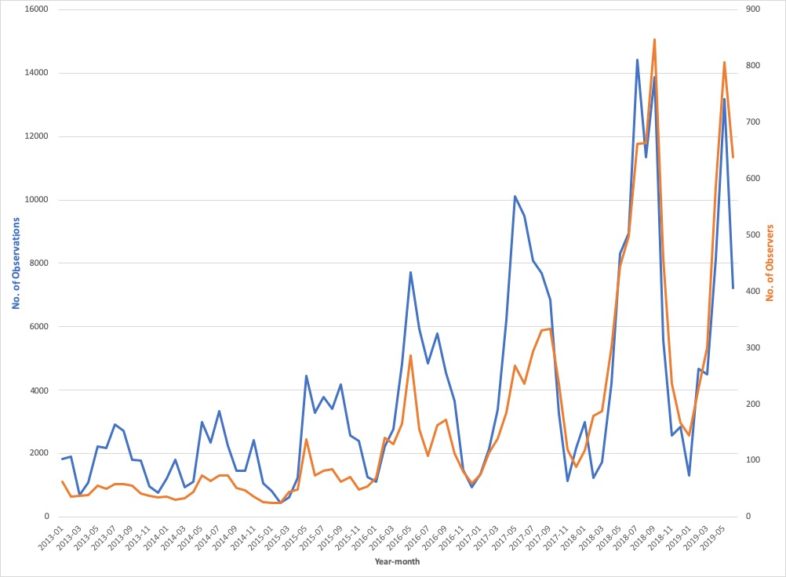
Hudsonian Whiteface captured, photographed, released, and shared with the Vermont Atlas of Life on iNaturalist. Click on the image to see the record. / © Sean Beckett
When Sean Beckett swung his net at a dragonfly in Peacham Bog yesterday, he made history. His observation was the 300,000th for the Vermont Atlas of Life on iNaturalist, making this one of the largest biodiversity datasets ever gathered for the state. And Sean is joined by more than 5,000 other observers that have made this happen in just over six years.
Sean’s dragonfly was an Hudsonian Whiteface, a lover of peatlands. It is often the first to take flight over bogs and fens, sometimes as early as April. Sean carefully took it from the net, photographed it, and released it. Shortly after he shared it, two of Vermont’s dragonfly experts and partners on the Vermont Atlas of Life Dragonfly and Damselfly Atlas agreed with Sean’s identification, making it a ‘research grade’ observation and usable for biodiversity conservation and science.
From moss to moose, fungi to falcons, together, we’re compiling one of the largest biodiversity datasets ever assembled for Vermont. It now contains information on almost 5,000 verified species records, including information on phenology, habitats, and more.

Begun in 2013, the Vermont Atlas of Life on iNaturalist has grown rapidly and steadily over the past 6 years.
How many species occur in Vermont? You’d think we’d know this for a small state steeped in a rich tradition of naturalists. But, the simple answer is, no one really knows. We do know how many species there are of some of the popular taxonomic groups like birds (currently 382) and mammals (58). But how many invertebrates are there in Vermont? A back-of-the-envelope estimate puts the number at just over 21,400 species! There are about 2,150 species of vascular plants, with approximately 1,400 native plants. Not including protists, bacteria or viruses, we humans share Vermont with at least 26,000 to 45,000 species.
Join our growing community of citizen naturalists from around the Green Mountain State in discovering and sharing observations of Vermont life. Your observations can be turned into research-grade, citizen science data that will help us discover, track and ultimately conserve our natural heritage.

What an exciting article!! 300,000 observations is incredible. I only wish I lived in VT instead of NY so that I could contribute to this wonderful database that has been developed. Thank you for such an uplifting story.
The cool think about iNaturalist is that you can use it anyplace in the world! There’s even a free smartphone app! It is so much fun!
Thanks, Kent! I didn’t know about the app. I’m going to download it right now.
It is so so so much fun. Let me know if you have any trouble getting started! Here’s a few resources that might help with that too:
1. short video tutorials to help get you started (https://www.inaturalist.org/pages/video+tutorials)
2. infographics that quickly show how to get started (https://www.inaturalist.org/pages/getting+started)
Thanks again, Kent. I feel rather ridiculous right now since it turns out I did install the app when I was in SC this past winter!! I even put up some photos that were verified. I think my brain must have gone on vacation since I have no recollection of doing that!! Dragonflies are among my favorite species. I have a couple of photos of some of them from SC that I haven’t been able to ID. I should put them on iNaturalist and see what people come up with. It would be wonderful to finally have an answer as to their identity. Sorry about my brain glitch, Kent. I seem to be a little more put together now🤪.